Awareness on the Effects of Irrigation Farming on Farmers’ Yield and Income: Evidence from Jibia Irrigation Katsina State, Nigeria
Tijjani Abu Rimi1*, Abba Y Abdullah2 and Dandela Ibrahim3
1Department of Agricultural Extension and Rural Sociology, Federal University, Nigeria
2Aquagric Ltd, No.1 KTARDA Headquarter Kano Road Katsina, Katsina State, Nigeria
3KTARDA Headquarter Kano Road Katsina, Katsina State, Nigeria
Submission: July 29, 2022; Published: August 15, 2022
*Corresponding author: Tijjani Abu Rim, Department of Agricultural Extension and Rural Sociology, Federal University, Nigeria
How to cite this article: Tijjani Abu R, Abba Y Abdullah, Dandela I. Awareness on the Effects of Irrigation Farming on Farmers’ Yield and Income: Evidence from Jibia Irrigation Katsina State, Nigeria. Agri Res & Tech: Open Access J. 2022; 26 (5): 556354. DOI: 10.19080/ARTOAJ.2022.26.556354
Abstract
Peasantry irrigation farming is cardinal to food security, livelihood improvement and poverty alleviation of rural dwellers. However, little has been done to ascertain its effects on farmers’ yield and income. Therefore, the current research examined the effects of irrigated farming in yield and income of the smallholder farmers, in Jibia, North Western Part of Nigeria. A multi-stage sampling technique was employed to select two hundred and thirty four farmers. Data was analyzed using standard tools of descriptive statistics. The results shows that male dominate farming and majority are in productive age, also, respondents had adequate years of irrigation experience and households size, but large number lack western education and doesn’t participate in cooperatives. The analysis further revealed that respondents’ main information sources were input dealers, followed by farmers’ group and family/friends. Additionally, the outcome of the research indicates that farmers’ cultivate both cereals/vegetable crops such as wheat, maize, rice, beans, groundnut, millet, onion, cabbage and water melon. Further findings indicated that farmers’ obtained high yield and income. However, constraints to irrigation farming identified include; low women involvement, limited literacy and weak participations in cooperatives. It was concluded that, crop production under irrigation farming is crucial for enhanced yield and income. The findings recommend that augmenting farmers’ access to production inputs, inculcating appropriate knowledge of the practices and provision of adequate irrigation resources are crucial to meeting food security and poverty eradication globally, in all its appearances.
Keywords: Awareness; Effect of irrigation; Farmers’ yield and income; Jibia Katsina State
Introduction
Improvement of irrigation infrastructure would facilitate small-scale farmers’ access to portable irrigation water, enhanced crop yield and economic performance [1-8]. Therefore, augmentation and sustainability of irrigation facilities is a fundamental for attaining food security and improvement of peasantry livelihoods. An aggregate empirical findings have shown improvements on farm economic returns and household welfare from irrigation improvement [8-18] For instance, [10] revealed that agricultural income has been overwhelmingly witnessed from farmers’ adoption of small-scale irrigation farming in South Africa. While, [2] affirmed that farmers partaking in irrigation farming demonstrated more economic returns on rice production than their counterpart under the rain-fed production in Ghana. Previous researches in Ethiopia and Malawi, both Ahmed [19], and [20], confirmed that irrigation development has impacted substantially on the farming families’ crop yield and net income.
However, in Nigeria most of the dams are either under-utilized for irrigation or abandoned, with utilization of the project at just about 50% of the crop area under conditions of water shortage or insufficient irrigation [13]. Though, studies have been done in the country on economic analysis and impact of irrigation on crop yield, income, food security and livelihoods. While, [12] studied impact of irrigation technology use on crop yield, income and household food security in Nigeria. Whereas, [14], assessment of irrigation system on crop production and farmers ‘economy in Lagos state, south west Nigeria. According to [21], efficiency,food security and differentiation in small-scale irrigation agriculture in Sokoto state northwest Nigeria. Similarly, in the study area [11], examined economic analysis of crop production under Jibia irrigation project. Also, Sulaiman [22], analyzed the impact of Jibia dam irrigation project on wheat production and farmers’ livelihood. However, none of the studies done in the research area that examine yield and income, and this justify the research. It is against this background that this research seek to investigate the extent at which farmers’ tap this resources in terms of crop yield and income.
The objectives of the study
The main objective of this research is to examine Awareness on the Effects of Irrigation farming on farmers’ yield and income: Evidence from Jibia irrigation Katsina State, Nigeria. Specifically, this study is undertaken to:
a. Describe the socioeconomic characteristics of irrigation farmers in the study area
b. Explore the source of farmers’ information on irrigation practices
c. Examine various crops production undertaken in the scheme
d. Determine the effect of irrigation farming on yield and income
Research Methodology
Study Area
The study specifically covers Jibia Irrigation Project that is situated in Jibia Local Government Area of Katsina State. The LGA is blessed with abundant productive arable land that enable numerous crop to thrived, and thus, attracts intensive crop production of both vegetables and arable crops respectively [23]. Geographically, Jibia Local Government area is situated at the north-western enclave of Katsina State. It borders Batsari and Batagarawa Local Government areas to the south, Katsina and Kaita Local Government areas to the east, Zurmi Local Government Area of Zamfara States; to the west and to the north it shares an international border with Niger Republic. It lies between latitude 1205’ and 13016’N and longitude 702’ and 7049’E, whereas, the project is between latitude 1205’ and 1309’N and longitude 701’ and 704E [6]. The area is belongs to savanna vegetation and a single rainfall regime. Temperatures are high throughout the year, reaching a peak of 40 degrees Celsius in March and June. Agriculture is the main economic activity in the study area. Major crops grown in the area include maize, rice, yam, groundnut, and soybean. Majority of the farmers in the study area produce at subsistence level.
Sampling Method
The current study adopted a two-stage sampling procedures were used to select the sample for the study. In the first stage, the entire irrigation project operates within six intakes i.e. (F1, F2, F3, F4, F5 and F6) and based on this, stratified sampling was employed to select respondents from each strata in order to have equal representations. In the second stage, and based on the lists of farmers obtained from (SRRBDA) office, a systematic random selection was done to select respondents from each stratum proportionately that give a total of 234 farmers for this study.
Analytical Techniques
The sets data extracted were then transformed to descriptive and inferential statistics which includes frequency tables and percentage in order to show brief background information as regards the socioeconomic features of the population under study. Statistical Package for Social Science (SPSS) 2017 version was the software utilized in analyzing the results (Table 1).

Source: Field survey, 2021.
Gender
The results of gender in Figure 1 showed that (98%) of the respondents were males, with a minority (2%) proportion belongs to female counterparts. This finding revealed that women headed households failed to adopt small scale irrigation technologies because of technological characteristics and its labor demands in the study area.
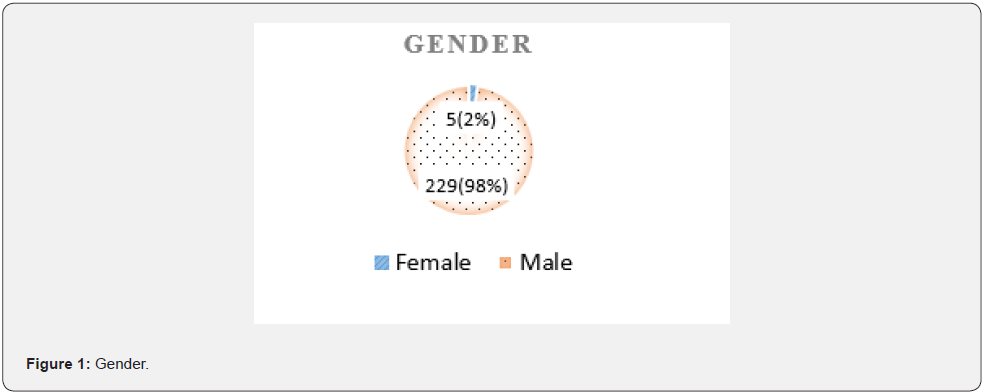
Age of the respondents
The age of the farmers in the households in (Figure 2) ranged from 20 to 60 years. About (71%) of the respondents fell within the productive age of 21-50 years. This advocates that the large proportion of the respondents were within their economic active age and this enhances their efficiency for food security. The age group 51-70 had little effect in farm work constitute (27%).
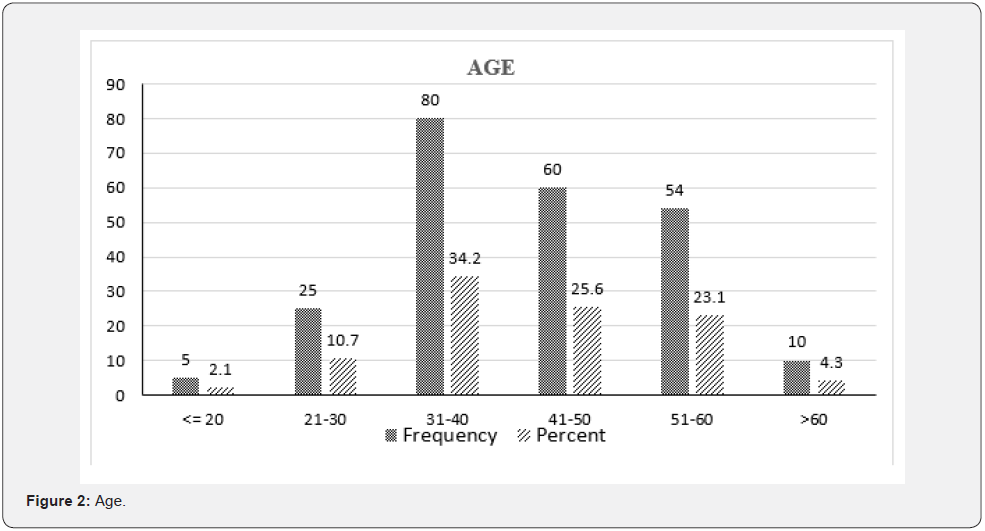
Farming experience
The result of years of farming experience in Figure 3 shows that (86.3%) of the respondents had between 6–20 years’ experience. The group with less than 5 years’ experience was the least (13.7%) and this signify that greater majority embrace irrigation farming occupation.
Household size
The household size of the respondents revealed that majority (55.5%) had 6-15 household size, whereas 15.0% had 16-20 household size, even though (24.8%) had less than 5, and the least (4.7%) had above 20 people in the household. This implies that greater majority (75.2%) had adequate household size to curtail labor costs to be incurred (Figure 4).
Education
The result of educational level adduce that (62.4%) of the re-spondents are literate in Islamic education (Ajami), also, (23.1%) had primary and secondary education respectively. Only (14.6%) respondents possessed higher education (Figure 5).
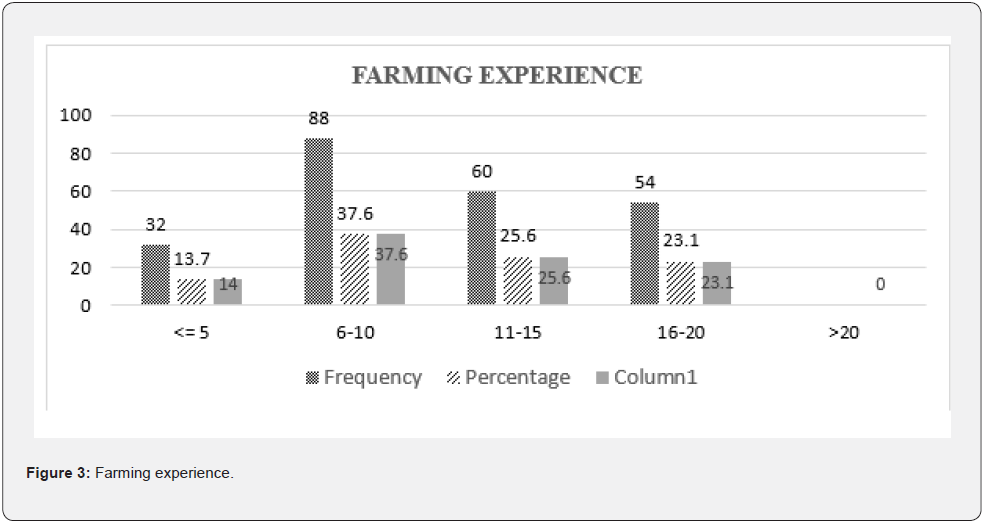
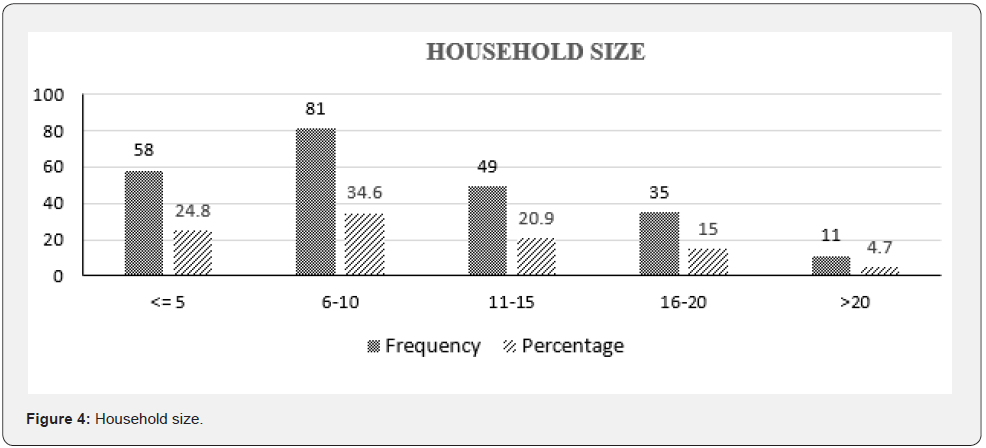
Membership of Cooperative
The finding of the analysis in Figure 6 document that the minority percentage (28%) belongs to farmers group cooperative. While very close to two-third percentage (72%) doesn’t partake in any form of farmers’ group. The absence of group participation denied farmers’ access to information and other institutional supports in terms of loans facility to boost production, as current government and foreign interventions are channeled through group approach.
Source of Farmers’ Information
Result in Table 2 illustrate farmers source of irrigation farming information, which inferred that input dealers are the most reachable source (34.2%) followed by farmer groups (25.6%). Family/Friends (23.1%) was the next, followed by extension services (10.7%), radio 4.3% and mobile phone (2.1%).
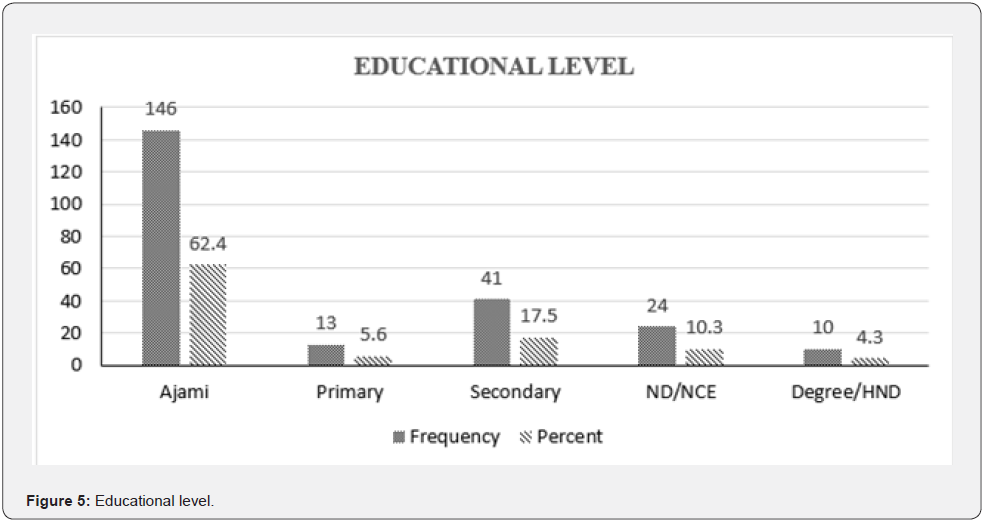
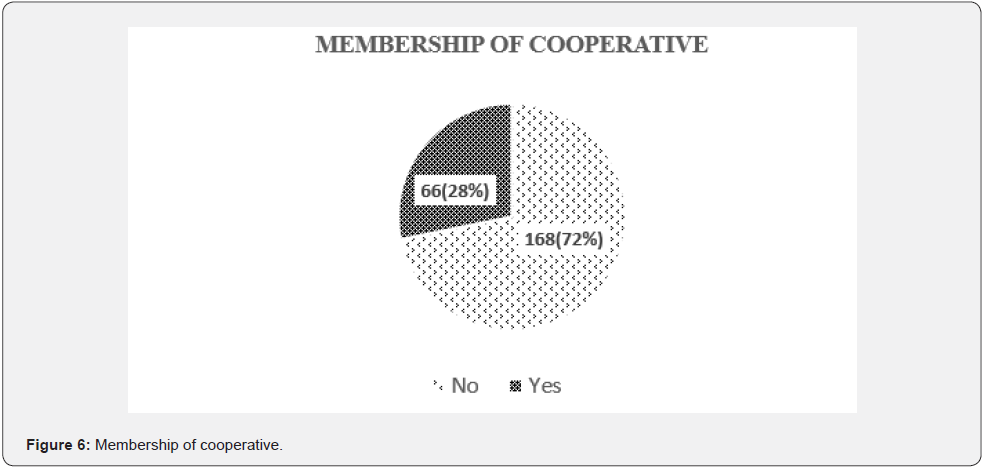
Crop Cultivated by Farmers
To ensure maximum production efficiency in the face of total crop failure, farmers cultivate both cereals and vegetable crops. The finding in Table 1 infers that among respondents that cultivate cereals, the larger 18.8% were maize producers, followed by millet 16.2%, whereas, 13.7% and 13.2% dwell on groundnut and beans production respectively, while 9.4% for wheat producers, with the least 2.7% cultivate rice. Furthermore, between cultivators of vegetables, onion occupy the highest proportion 12.4%, followed by cabbage 8.1% and water melon 5.1%, with the smallest 0.4% cultivate pepper.
Farmers’ Production Yield
Result of the analysis on crop yield indicate that farmers’ obtained 32,408 Kg of wheat, 93,694 Kg of maize, 5,925 Kg of rice were recorded, whereas, 39,592Kg of beans was produced during the irrigation season. They also obtained 34,575Kg of groundnut and 62,032.00Kg of millet. On the part of vegetable production, four vegetables (Cabbage, Onion, Watermelon, Pepper) exceled during the irrigation production season. Farmers at Jibia Irrigation Site harvested 35,200Kg of cabbage, which was the highest yielded vegetable, 34,992Kg of onion, 19,725Kg of watermelon, and 1,500Kg of pepper (Table 3).
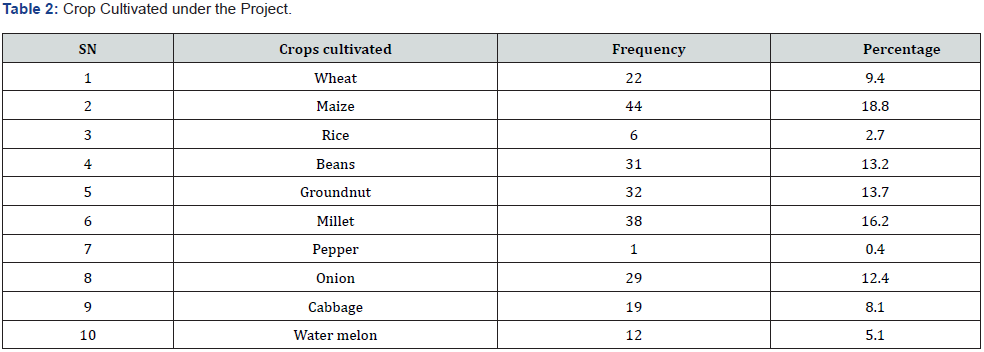
Source: Field survey, 2021.
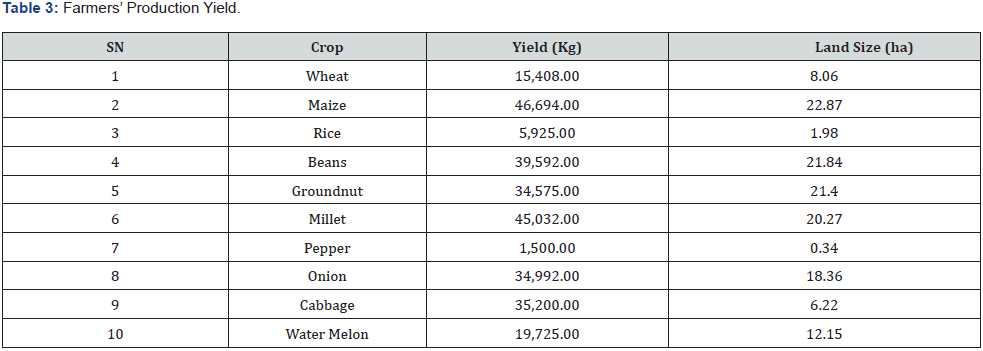
Source: Field survey, 2021.
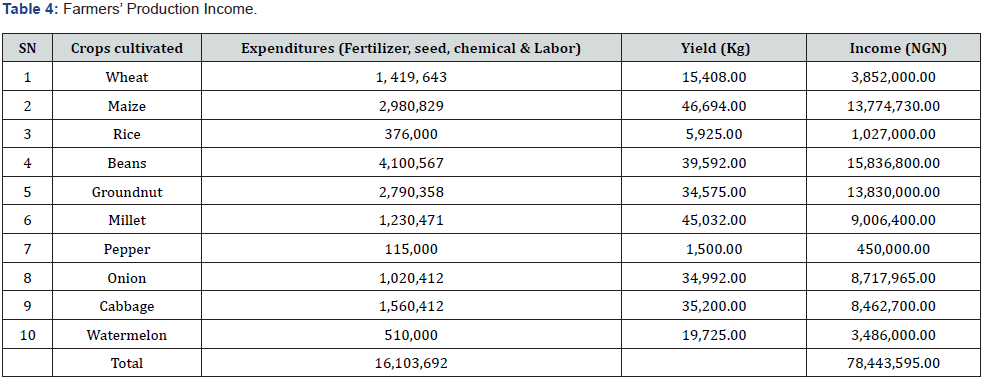
Source: Field survey, 2021.
The finding in Table 4 displays incomes accrued to farmers’ from the sales of various crops. Beans has the highest generating revenue from the staple food, it generate the income of ₦15,836,800.00 followed by Groundnut had the income of ₦13,830,000.00, preceded by Maize ₦13,774,730.00 then Millet ₦9,006,400.00. Others are wheat with income of ₦3,852,000.00 and rice provide an income of ₦1,027,000.00. On the vegetable crops, Onion generated the highest income of ₦8,717,965.00, followed by Cabbage which has the income of ₦8,462,700.00, Watermelon was the third that generate an income of ₦3,486,000.00, and Pepper generates the least income of ₦450,000.00 (Table 4).
Discussion of Findings
The results of demographic factors in Figure 1 infers that male dominated (98%) farming, and this could be possible due to marriage ties in the study area that subjected marriage women into daily household responsibilities in respect to family up-keeps, which restricted them from full irrigation farming participations. This is consistence with [24] study in Ethiopia showed that 90% and 84% of adapters and non-adapters were males respectively, while10% and 16% of adapters and non-adapters were females. Also, age of the farmers in (Figure 2) ranged from 20 to 60 years. About (71%) of the respondents fell within the productive age of 21-50 years. This advocates that the large proportion of the respondents were within their economic active age, and this enhances their efficiency for food security. This corroborate with [17] discovered that the adoption of irrigation technology fall within age categories of 41–50 years. The outcome of the analysis of years of farming experience in Figure 3 shows that (86.3%) of the respondents had between 6-20 years’ experience, and this imply that greater majority had sufficient years of irrigation experience. In the same context, [3] adduced that gravity irrigators have more years of experience in harnessing irrigation water (12 years) comparable to other alternatives.
Figure 4 unveil the household size of the respondents revealed that majority (55.5%) had 6-15 household size, and having 6-20 occupying (75.2%) implies that greater majority had adequate household size to curtail labor costs to be incurred. Conversely, [25] found that both the farmers that have access River Basin Development Authority facilities and those without access, have approximately 4 household members. The findings of education in Figure 5 adduce that (62.4%) had Islamic education and (23.1%) had primary and secondary education respectively, an indication that, more than two-third (85.5%) had limited western education to be conversant with irrigation practices that posed serious threat to food security. On the contrary view, study in Mississippi, USA by [16] found that more than half (65.6 percent) of the irrigation farmers had Bachelor degree. Lack of western education by the greater majority of farmers’ impede appropriate understanding of irrigation techniques. Consequently, result in Figure 6 document that very close to two-third percentage (72%) doesn’t partake in any form of farmers’ group. The absence of group participation denied farmers’ access to information and other institutional supports in terms of loans facility to boost production, as current government and foreign interventions are channeled through group approach. On the other hand, group involvement provide trust and embrace of technology due to peer influence. In line to this, a research conducted by [4] reported that membership in water organizations upsurges the likelihood of adoption indirectly, because its effects are mediated through subjective norms.
Findings in Table 2 illustrate farmers source of irrigation farming information, which inferred that input dealers are the most reachable source (34.2%) followed by farmer groups (25.6%) and Family/Friends (23.1%). Surprisingly, extension agents was amongst the least sources that negate the theoretical assertion that extension contact is related to adoption of innovation [26]. This has connection with gross shortage of the extension personnel in the study area, as attested by the respondents’ that there haven’t functional extension agent designate to the project. This concurred with empirical studies of [27] cited in [28] reported that the extension agents/farmer ratio in Katsina State to be 1:4000. That is far above the UN global standard of 1:500–800 and FAO 1:1000 for ease of coverage [5].
In the same vein, appearance of farmers groups as the second most information source become obvious, taking into cognizance of near to two-third (71.8%) of the respondents’ were not actively involve into any farmers’ group, and hence, they have no alternative than seek knowledge from this affiliations, since previous findings outlined the efficacy of such participations in terms of access to institutional interventions in terms of loan facilities, as well as a source of farmers’ information [15]. Furthermore, the finding of the varieties of crops farmers’ cultivate in Table 2 infers that under cereal crops, maize growers are the larger (18.8%), whereas, groundnut producers assume the leadership under legume crops (13.7%). Furthermore, onion emerge on top (12.4%) amongst vegetable cultivators. The result corroborate with empirical discoveries of [29] and [30] affirmed that, similar to rain fed production, farmers also cultivate multitude of crops during irrigation farming. Consistence to this, [31] documented that drip irrigation farmers’ in Ethiopia, cultivated tomato, onion, cannonball cabbage and garlic. Whereas, in Ghana, combined sweet potato, cucumber and green pepper. As in the case of Tanzania, they produced Chinese cabbage and African nightshade.
Result of the analysis in Table 3 on crop yield indicate that farmers’ obtained substantial outputs. Under cereal crops, maize has the highest 93,694Kg (936.94) bags. Followed by beans that belongs to leguminous crops having an outputs of 39,592Kg (395.92) bags. On vegetable crops the highest yield goes to onion 34,992Kg (269.17) bags. This milestone of production outcomes achieved is attributed to steady water supply free of charge, couple with subsidized fertilizer among others. Consistence to this, is the study by [32] revealed that the enhancement of irrigation access and input supply have considerably facilitate yield increase of farmers in China. Additionally, Table 4 displays incomes accrued to farmers’ from the sales of various crops. Within cereal crops, beans has the highest generating income of ₦15,836,800.00. More so, onion generated the highest turnover from vegetable crops ₦8,717,965.00. It is pertinent to note that, the sum of Sixteen Million, One Hundred and three Thousand, Six Hundred and Ninety Two Naira (₦16,103,692) were expended in the course of production, while, Seventy Eight Million, Four Hundred and Forty Three Thousand Five hundred and Ninety Five Naira only (₦78,443,595) accrued in the producers coffers. Efforts to curtail food insecurity via irrigation augmentation has been steadily progressing, considering the substantial yield and revenue accumulated within one growing season, and if other production constraints are ameliorated, the fortune of the irrigation farming families and the country could reach an enviable height. This corroborate with a research in India by [33] claimed that access to irrigation in rural areas boosted households incomes. In line to this, research conducted in Northwestern Ethiopia by [34] established that irrigation farming has overwhelmingly enhanced the lots of smallholder farmers in respect to revenue generated, leading to high purchasing power and wellbeing of their livelihoods.
Conclusion
Conclusively, the study provides knowledge on the effect of irrigation farming on farmers’ yield and income, provide inferences to stakeholder in formulating future research policy direction on irrigation investment in the study area and beyond, as well as to informed farmers on the fortune associated with the enterprise for embracing it enthusiastically. The findings unveils that male and youthful age dominate production, while, respondents have adequate years of experience and household size to cater production and it further reveals that, more than two-third have neither had western education nor partake in farmers’ cooperative. The outcome also indicate that the major sources of information were; input leaders, farmers’ group and friends/relative, and the least were extension agent, radio and mobile phone respectively. The analysis equally portrays that farmers cultivate a wide range of crop varieties in mixture of cereals and vegetables. Furthermore, the result documented that farmers’ obtained a substantial yield and income.
Recommendations
According to the study discoveries the following recommendations are proffer to further guide irrigation policy in Nigeria
a. Adequate and qualified extension agents/subject matter specialist need to be available for effective technology transfer
b. Farmers’ need to be thoroughly educated through adult literacy programs that will helps them to be conversant with farming practices, and see the benefits of patronizing cooperative movement.
There is need for a strong government policy to bridge gender imbalances for enhanced irrigation production efficiency.
References
- Balana BB, Bizimana JC, Richardson JW, Lefore N, Adimassu Z, et al. (2020) Economic and food security effects of small-scale irrigation technologies in northern Ghana. Water Resources and Economics 29: 100141.
- Bidzakin JK, Fialor SC, Awunyo V, Yahaya I (2018) Impact of irrigation ecology on rice production efficiency in Ghana. Advances in Agriculture, p.1-10.
- Bekele RD, Mirzabaev A, Mekonnen D (2021) Adoption of multiple sustainable land management practices among irrigator rural farm households of Ethiopia. Land Degradation & Development 32(17): 5052-5068.
- Castillo GML, Engler A, Wollni M (2021) Planned behavior and social capital: understanding farmers’ behavior toward pressurized irrigation technologies. Agricultural Water Management 243: 106524.
- Davis K, Lion K, Arokoyo T (2019) Organizational capacities and management of agricultural extension services in Nigeria: current status. South African Journal of Agricultural Extension 47(2): 118-127.
- Funtua AI, Musa H (2020) Analysis of a Dam Induced Land Changes and It’s Impacts in Parts of Jibia Local Government Area Katsina State Nigeria. African Scholar Journal of Environmental Design & Construction Management 22(4): 167-176.
- Hakizimana N, Nishimwe O, Nahayo LMA (2020) Impact of Irrigation Projects on Rural Community Livelihoods in Rwanda. American Journal of Environment and Sustainable Development 5(2): 30-36.
- Osewe M, Liu A, Njagi T (2020) Farmer-Led Irrigation and Its Impacts on Smallholder Farmers’ Crop Income: Evidence from Southern Tanzania. International Journal of Environmental Research and Public Health 17(5): 1512.
- Li C, Xiongn Y, Cui Z, Huang Q, Xu X, et al. (2020) Effect of irrigation and fertilization on grain yield, water and nitrogen productivity of mulching cultivated maize (Zea mays) In the Hetao Irrigation District of China. Agricultural Water Management 232.
- Mango N, Makate C, Tamen, L, Mponela P, Ndengu G (2018) Adoption of small-scale irrigation farming as a climate-smart agriculture practice and its influence on household income in the Chinyanja Triangle, Southern Africa. Land 7(2): 49.
- Musa J, Baba KM, Beli SA (2013) Economic Analysis of Crop Production under Jibiya Irrigation Project, Katsina State, Nigeria. Nigerian Journal of Basic and Applied Sciences 21(4): 283-290.
- Ogunniyi A, Omonona B, Abioye O, Olagunju K (2018) Impact of irrigation technology use on crop yield, crop income and household food security in Nigeria: A treatment effect approach. AIMS Agriculture and Food 3(2): 154-171.
- Oluniyi EO, Bala MS (2021) Irrigation management in Nigeria: Lessons from the Kano River irrigation scheme. Irrigation and Drainage 70(3): 517-523.
- Olaniran JA, Ojo OI, Olatunji KO (2019) Assesment of Irrigation System on Crop Production and Farmers'economy in Lagos State, Nigeria. Annals of the Faculty of Engineering Hunedoara-International Journal of Engineering 17(4).
- Petcho W, Szabo S, Kusakabe K, Yukongdi V (2019) Farmers’ perception and drivers of membership in rice production community enterprises: evidence from the central region, Thailand. Sustainability 11(19): 5445.
- Quintana AN, Gholson DM, Krutz LJ, Henry CG, Cooke T (2020) Adoption of water-conserving irrigation practices among row-crop growers in Mississippi, USA. Agronomy 10(8): 1083.
- Saleh A, Bako RB, Suleiman ML (2021) Factors influencing acceptance of farmer education and irrigation technology for sustainable food production in Kwanar Are Dam–Katsina State. Fudma Journal of Sciences 5(4): 142-148.
- Silveira LK, Pavao GC, dos Santos Dias CT, Quaggio JA, Pires RC, et al. (2020) Deficit irrigation effect on fruit yield, quality and water use efficiency: a long-term study on Pera-IAC sweet orange. Agricultural Water Management 231.
- Ahmed J (2019) The Role of Small Scale Irrigation to Household Food Security in Ethiopia: A Review Paper. J Resour Dev Manag 60: 20-25.
- Adeniyi DA, Dinbabo MF (2020) Efficiency, food security and differentiation in small-scale irrigation agriculture: Evidence from North West Nigeria. Cogent Social Sciences 6(1): 27-40.
- Schuenemann F, Thurlow J, Meyer, Robertson R, Rodrigues J (2018) Evaluating irrigation investments in Malawi: economy-wide impacts under uncertainty and labor constraints. Agricultural Economics 49(2): 237-250.
- Sulaiman B (2016) Impact of Jibia dam irrigation project on wheat production and livelihood of benefiting farmers in Katsina state, Nigeria (Unpublished PhD Thesis, Ahmadu Bello University Zaria).
- Musa H, Na’iya KH (2021) Modelling Floodplain areas in Jibia town and its Environs Using Geospatial Techniques. African Scholar Journal of Env. Design & Construction Mgt 22(4).
- Teha D, Jianjun L (2021) Factors Affecting Adoption of Small Scale Irrigation Technology: Insights from Sire Woreda, Oromiya Region, Ethiopia. American Journal of Applied Scientific Research 7(4): 84-101.
- Kolawole AO, Oluwatusin FM, Ajiboye A, Aturamu OA, Akokoh FE, et al. (2020) Poverty status analysis of irrigation farming households in Nigeria. World Rural Observations 12(2): 15-26.
- Anang BT, Bäckman S, Sipiläinen T (2020) Adoption and income effects of agricultural extension in northern Ghana. Scientific African 7: 1-12.
- Haruna SK, Abdullahi YMG (2013) Training of public extension agents in Nigeria and the implications for government’s agricultural transformation agenda. Journal of Agricultural Extension 17(2): 98-104.
- Tijjani AR (2021) Relationship between Extension Agents’ Technical Skills, Information Dissemination, Extension Methods and Adoption of Improved Groundnut Varieties by Farmers in Northwestern Nigeria (Unpublished PhD Thesis, Ahmadu Bello University Zaria).
- Joel AO, Olumuyiwa IO, Kehinde OO (2019) Assessment of irrigation system on crop production and farmers’ economy in Lagos state, Nigeria. International Journal of Engineering 4: 174-182.
- Smid, SJ, Kendall AD, Hyndman D (2019) Increased dependence on irrigated crop production across the CONUS (1945–2015). Water (7): 1458.
- Assefa T, Jha M, Reyes M, Worqlul AW, Doro L, et al. (2020) Conservation agriculture with drip irrigation: Effects on soil quality and crop yield in sub-Saharan Africa. Journal of Soil and Water Conservation 75(2): 209-217.
- Song J, Guo Y, Wu P, Sun S (2018) The agricultural water rebound effect in China. Ecological Economics 146: 497-506.
- Zaveri ED, Wrenn DH, Fisher VK (2020) The impact of water access on short-term migration in rural India. The Australian Journal of Agricultural and Resource Economics 64(2): 505-532.
- Zewdie MC, Van PS, Moretti M, Annys S, Tenessa DB, et al. (2020) Pathways how irrigation water affects crop revenue of smallholder farmers in northwest Ethiopia: A mixed approach. Agricultural Water Management 233: 106101.






























